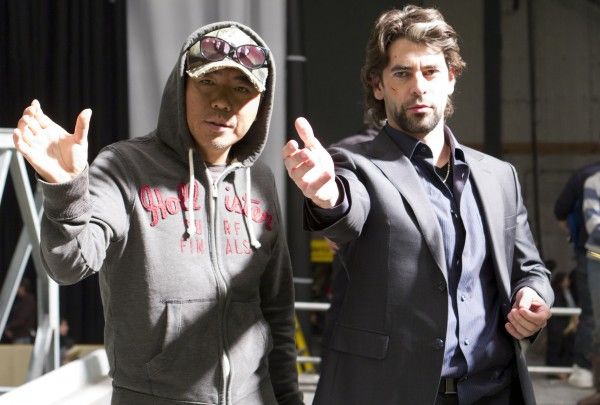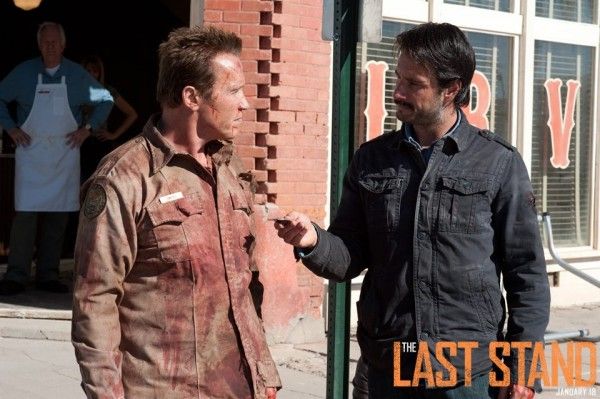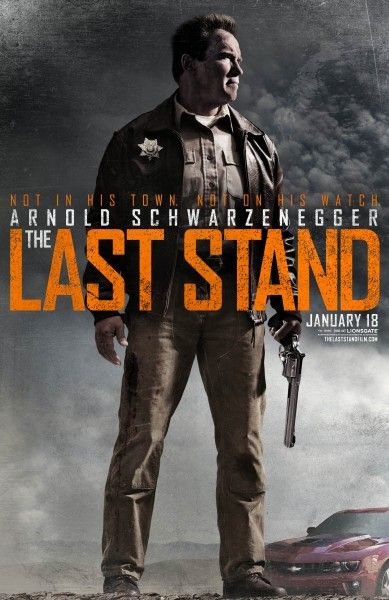After directing hit films A Tale of Two Sisters; The Good, The Bad, The Weird; and I Saw the Devil, Korean director Kim Jee-woon makes his American debut with The Last Stand (watch the new trailer here).  The stylized Western stars Arnold Schwarzenegger as retired LAPD officer turned sheriff, Ray Owens, who settles in the peaceful border town of Sommerton Junction.  When cartel leader Gabriel Cortez (Eduardo Noriega) escapes from the FBI and makes a run for the border, Owens and his small-town sheriffs department are the only things standing in his way.During our set visit to The Last Stand, Kim Jee-woon (and his translators) took the time to participate in a round-table interview to talk to us about the film, the difference between Korean filmmaking and the American studio process, the style he brings to The Last Stand, whether he ever intended on coming to Hollywood, his physical directing style and how it feels to have Schwarzenegger starring in his American debut.  Hit the jump to check out our interview with Kim Jee-woon from our set visit to The Last Stand.How has the transition between Korean filmmaking and studio filmmaking been so far?Jee-Woon Kim: (through interpreters Jacob and Tommy): Obviously, I’ve made several films in Korea, so I’m very well accustomed and acclimated to Korean filmmaking. To say that I’ve needed a point of transition to get accustomed to it goes without saying. I feel that there are strengths and weaknesses to both styles of filmmaking, so I’ve been able to find the best of both and I believe the result will speak for itself.I feel that there is much more immediacy in the mornings from the crew call until the time we’re able to shoot, there’s much quicker turn around and we’re able to get ready much more quickly. I think time is the most valuable commodity here and we’re very sensitive about it and the way we treat it with delicate hands. That’s very effective here, as well. There’s a very distinct style to Korean filmmaking, particularly your films. Will that fingerprint still be on this film or will it have been adapted to a more American stylistic?Kim: Because it is sort of a hybrid, it’s tough to say whether it’s going to be more of one side or the other, but if I were to make a comparison, it would be an American canvas with my colors on it. That’s probably the way I would best describe it.Using the strengths of the American system, the American process, and melding that with my strengths and utilizing that, is probably one of the biggest reasons why I’m here. I’ve needed the time to get comfortable and to get acclimated; certain things have been uncomfortable for me, that goes without saying. But just as a man and a woman from different backgrounds meet, they need a time of adjustment, but eventually they learn how to get along and they have a baby, they buy a house. So, ultimately with this movie and the next one, I hope to do that. So was it always your goal to transition to Hollywood eventually or did this happen by accident?Kim: I’m someone who has a singular goal in making films; I want to tell a story. There are certain stories that I want to tell. Hollywood’s never really been the ultimate goal for me. This seems to be the end result of a process. I just make movies and tell stories that I want to tell and this is where I’ve [arrived], making one with Arnold (Schwarzenegger), Forest Whitaker and Peter Stormare. It’s more of the fact that it’s a very organic process that led me here. There was a picture that was released with me and Arnold. One of my friends in Korea showed me the picture and said, “We didn’t realize that was you for a while.†They didn’t realize that I was actually here making it; it was very surreal.  Arnold was talking about you being a very physical director, you act out all of the characters. Is that something that has gotten more so because of the language barrier or is that always your directing style?Kim: I do it in Korea as well. My background is in acting so I enjoy being able to show what I’m looking for. With acting, it’s very immediate when you show someone what you’re looking for and the feedback is instantaneous as well. I like it that way because I feel that there is no interpretation necessary. There are a couple of actors I’ve worked with, like Byung-Hun Lee and other Korean actors, who say, when I start acting it out, they say, “Please don’t act it out anymore. Stop.†[laughs] So that’s the frequency of which I act. I haven’t heard that from anyone so far, so I know I’m on the right track. Before Arnold Schwarzenegger stepped away from movies, he was a big international star. What’s it like having him in your first American movie?Kim: For me, it’s still a bit surreal. It hasn’t really sunk in, working with Arnold. It’s funny because a lot of people in Korea, both my friends and Korean filmmakers and fans are very curious as to what type of product will come out of this partnership between Jee-Woon Kim and Arnold Schwarzenegger. One of my favorite Arnold films is Last Action Hero and I feel like I’m actually in that film with the characters. The Last Stand is a contemporary Western with, obviously, action. Have you drawn from any of Arnold’s films or any other Western films for your inspiration?Kim: I’ve made the film The Good, the Bad, the Weird which was a Eastern Western film. Obviously, the Western film is American and American only; there’s really no Western genre over in Asia. With that being said, I feel that there are two things I’d really like in this film with Arnold: the one part is that I’d like to give the audience what they’ve always wanted to see and also I want to give the audience what they’ve never seen from him. It’s these two things I’m striving for.
Arnold was talking about you being a very physical director, you act out all of the characters. Is that something that has gotten more so because of the language barrier or is that always your directing style?Kim: I do it in Korea as well. My background is in acting so I enjoy being able to show what I’m looking for. With acting, it’s very immediate when you show someone what you’re looking for and the feedback is instantaneous as well. I like it that way because I feel that there is no interpretation necessary. There are a couple of actors I’ve worked with, like Byung-Hun Lee and other Korean actors, who say, when I start acting it out, they say, “Please don’t act it out anymore. Stop.†[laughs] So that’s the frequency of which I act. I haven’t heard that from anyone so far, so I know I’m on the right track. Before Arnold Schwarzenegger stepped away from movies, he was a big international star. What’s it like having him in your first American movie?Kim: For me, it’s still a bit surreal. It hasn’t really sunk in, working with Arnold. It’s funny because a lot of people in Korea, both my friends and Korean filmmakers and fans are very curious as to what type of product will come out of this partnership between Jee-Woon Kim and Arnold Schwarzenegger. One of my favorite Arnold films is Last Action Hero and I feel like I’m actually in that film with the characters. The Last Stand is a contemporary Western with, obviously, action. Have you drawn from any of Arnold’s films or any other Western films for your inspiration?Kim: I’ve made the film The Good, the Bad, the Weird which was a Eastern Western film. Obviously, the Western film is American and American only; there’s really no Western genre over in Asia. With that being said, I feel that there are two things I’d really like in this film with Arnold: the one part is that I’d like to give the audience what they’ve always wanted to see and also I want to give the audience what they’ve never seen from him. It’s these two things I’m striving for.  One of the earlier films that I’ve referenced was High Noon. In High Noon you have a man who really puts up his life for something that others perceived as wasteful; it’s not necessary, it has no value. But it’s a man who has his own morals and principles and he’s sticking by them no matter what other people perceive. America is a country that, even with all its flaws, has been able to flourish because there is a certain ideology about fighting for what you believe in. What you choose to believe in, no matter how small or big it is, is what you believe in and that ideology has made America. I’d like to incorporate those things into this film.
One of the earlier films that I’ve referenced was High Noon. In High Noon you have a man who really puts up his life for something that others perceived as wasteful; it’s not necessary, it has no value. But it’s a man who has his own morals and principles and he’s sticking by them no matter what other people perceive. America is a country that, even with all its flaws, has been able to flourish because there is a certain ideology about fighting for what you believe in. What you choose to believe in, no matter how small or big it is, is what you believe in and that ideology has made America. I’d like to incorporate those things into this film.  At least with the main character, I really wanted to convey that it’s a fight of a man who’s willing to fight for his town, his family, for what he believes in; he’s willing to risk everything to uphold that. The main character is fighting for something that others perceive as very small and inconsequential. I want to be able to show that it’s one man’s fight. This is an action movie and it’s got popcorn elements, but it’s very rooted in that philosophy and that ideal that it’s about one man fighting for what he truly believes. Some of your past films like A Bittersweet Life and I Saw the Devil are fairly graphic with their violence. Can we expect the same thing with this one?Kim: There’s a certain tone in this film and the violence is not gratuitous or excessive; it’s within reason, within the tone and manner of the film. But still there’s enough to create a spectacle and there’s what people expect from me, as well. It’s grounded within the framework of the film. What’s your next project after this? Anything lined up?Kim: If this movie is a runaway hit than the next movie would be another American film. [laughs] There is something in the works to start shooting next summer in Korea. Here's more coverage from our visit to the set of The Last Stand:
At least with the main character, I really wanted to convey that it’s a fight of a man who’s willing to fight for his town, his family, for what he believes in; he’s willing to risk everything to uphold that. The main character is fighting for something that others perceive as very small and inconsequential. I want to be able to show that it’s one man’s fight. This is an action movie and it’s got popcorn elements, but it’s very rooted in that philosophy and that ideal that it’s about one man fighting for what he truly believes. Some of your past films like A Bittersweet Life and I Saw the Devil are fairly graphic with their violence. Can we expect the same thing with this one?Kim: There’s a certain tone in this film and the violence is not gratuitous or excessive; it’s within reason, within the tone and manner of the film. But still there’s enough to create a spectacle and there’s what people expect from me, as well. It’s grounded within the framework of the film. What’s your next project after this? Anything lined up?Kim: If this movie is a runaway hit than the next movie would be another American film. [laughs] There is something in the works to start shooting next summer in Korea. Here's more coverage from our visit to the set of The Last Stand:
- 20 Things to Know from Our Set Visit to The Last Stand Starring Arnold Schwarzenegger
- Arnold Schwarzenegger Talks The Last Stand, Returning to Acting, His Personal Favorite Characters from His Career and More
- Producer Lorenzo di Bonaventura Talks The Last Stand, Director Kim Jee-Woon's Unique Style and Working with Arnold Schwarzenegger in His Return
- Eduardo Noriega Talks The Last Stand, Playing the Villain, Fighting Arnold Schwarzenegger, Working with Director Kim Jee-Woon and Driving the ZR1 Corvette

